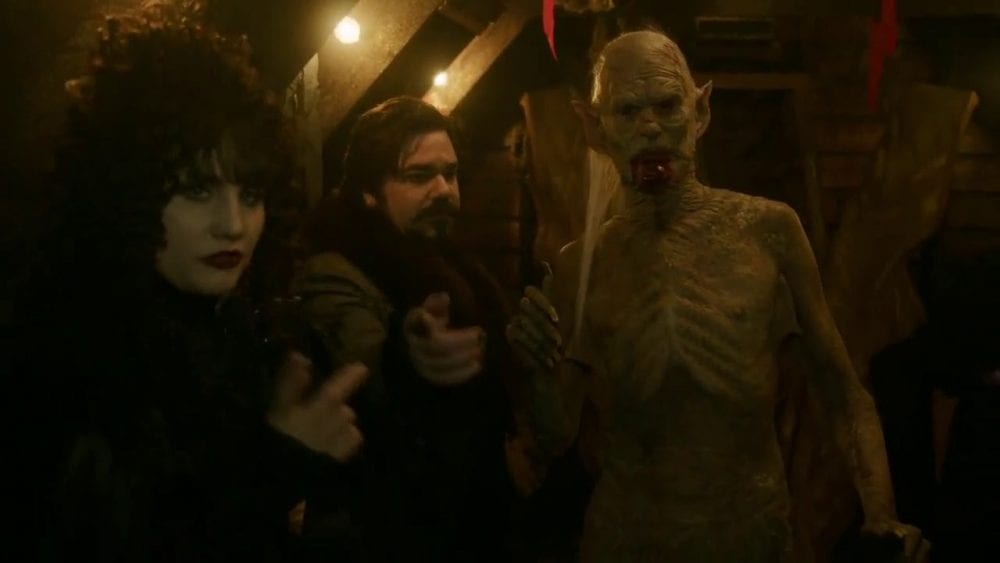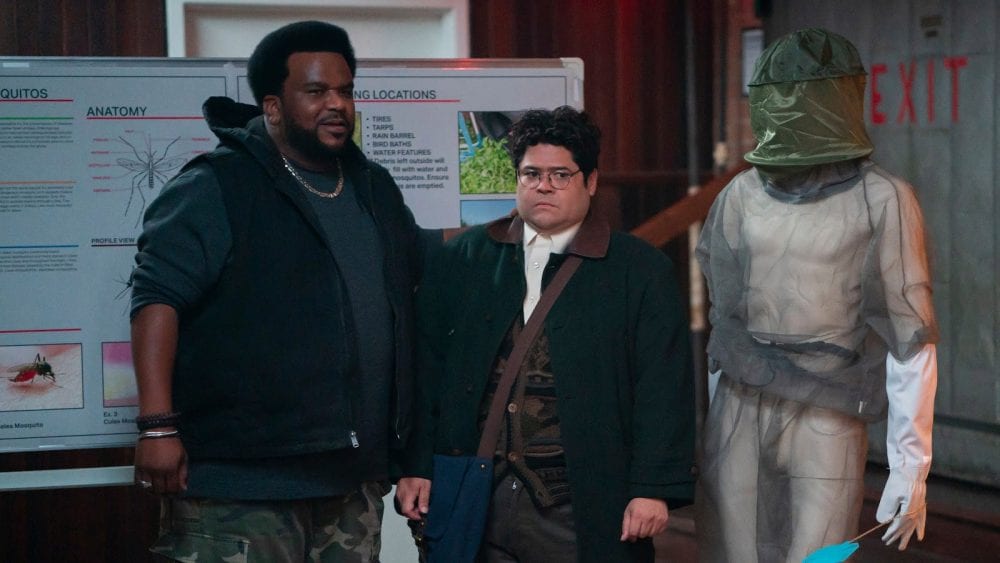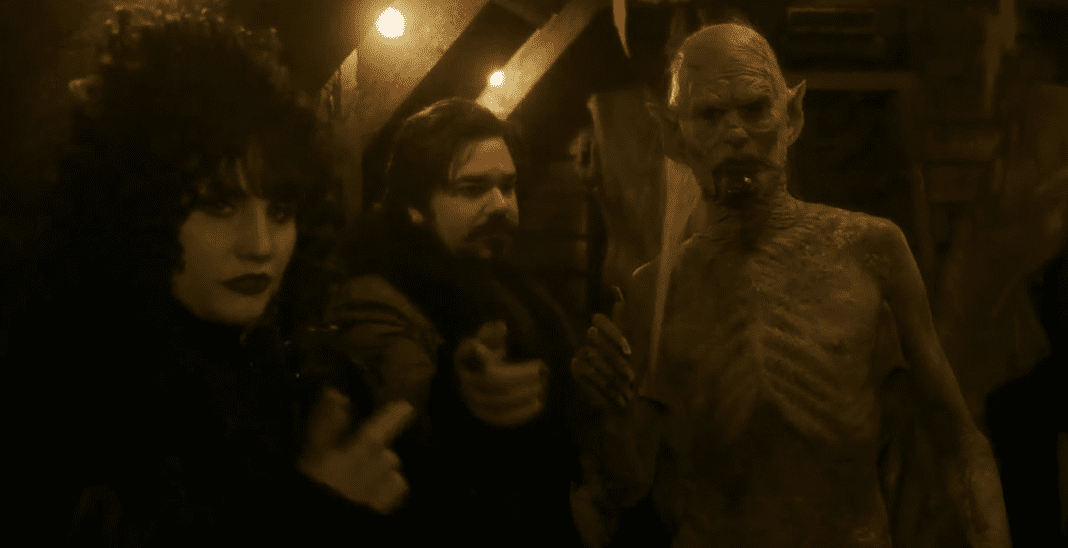So you’re trapped inside, and if you leave the house, you might literally die. There’s one group of people who can relate (at least during the daylight hours): vampires.
In What We Do in the Shadows, foolish mortal viewers are given a glimpse into the living arrangements of four vampires: Nandor the Relentless (Kayvan Novak), Nadja (Natasia Demetriou), Laszlo Cravensworth (Matt Berry), and energy vampire Colin Robinson (Mark Proksch) – not to mention their fifth housemate Guillermo (Harvey Guillén), Nandor’s human familiar.
This glimpse into undead domesticity is accomplished through the efforts of an intrepid camera crew, lending the story a “documentary” style feel. For What We Do in the Shadows, however, the documentary frame is more than the trendy method of filming a sitcom. Narrative perspective has been an integral element of the vampire yarn since Bram Stoker’s seminal gothic horror masterpiece, Dracula.
Dracula is an epistolary novel, or a novel that presents the story through a series of documents (in this case: a combination of letters, newspaper clippings, diary entries, and even medical reports). On one level, the technique lends verisimilitude to the proceedings: while a third-person omniscient narrative by its nature requires a certain suspension of disbelief, an epistolary novel might have been assembled from “real-world” documents. On another level, the very existence of an epistolary novel implies additional narrative: after all, someone had to write the letters and then collect and edit them and arrange them into a story.
What We Do in the Shadows follows a similar philosophy, adapted for the screen: the majority of the footage is credited to the on-scene documentary film crew and supplemented by clips from additional modern-day sources, like video from social media and security camera footage.
The series has capitalized off its narrative frame in multiple ways. First, the film crew’s recording of the vampires is presented in the same manner as many documentaries about non-fictional topics. We’ve all seen a million reality shows and HBO serial killer “investigations” at this point, so we’re used to seeing the spacious interiors of large, unkempt, poorly lit houses through the lens of a shoulder-mounted camera. The familiarity of the presentation – including the direct-to-camera testimonial sequences – means that slipping into a world populated by vampires, zombies, and babadooks instantly feels more believable.
In addition to capitalizing on the verisimilitude imparted by the documentary crew perspective, What We Do in the Shadows also benefits from the implied narrative created by the presence of the imperiled filmmakers.

This aspect of the story is made clear in the pilot episode of the series and subsequently toyed without throughout the first season. When the newly arrived Baron Afanas (Doug Jones) awakens from his slumber and emerges from his sarcophagus, he quickly notices the camera crew and asks if he’s being filmed. Although Nandor explains that they can just pretend they aren’t being filmed, the Baron returns to his grandstanding with his performance greatly amplified for the cameras.
In “Baron’s Night Out,” the presence of the documentary crew is again emphasized when the Baron attacks the sound engineer. Not only does this lead to a practical consequence – the sound feed that conveys the dialogue is immediately affected – but the implied narrative regarding the presence of the cameras is addressed when Nandor, Nadja, and Laszlo offer their apologies to the surviving crew regarding the late “sound recordist.”
In the ongoing second season, the presence of the film crew within the narrative has continued to expand. In “Brain Scramblies,” the vampires attend a Superb Owl party at their neighbor’s house. While most of the party attendees do not acknowledge the presence of the vampire’s camera crew, when their neighbor’s elderly mother comes downstairs in the middle of the festivities, she immediately spots the crew and asks if they’re making a movie. This both draws on the mythological supposition that those afflicted by “madness” may be capable of perceiving the truth behind magical illusions and adds more implied narrative to the story.

In “The Curse,” the film crew plays an even larger role. Early in the episode, when Guillermo arrives at the vampire hunter meeting, Claude (Craig Robinson) acknowledges the presence of the camera crew, saying that the world should know the truth about vampires. This line serves two purposes: not only does it remind the audience that the cameras on What We Do in the Shadows are actually “in the scene,” it also foreshadows the peril the crew will face as they document the vampire hunters’ raid of another Staten Island vampire domicile.
However, the sequence also adds an additional dimension to the show’s own vampire lore: while the magical protection imparted by the vampires over the camera crew may make them invisible to outsiders, that protection ceases to prove effective when they leave the presence of their primary, undead documentary subjects.
Come to think of it – that’s actually a pretty good reason not to leave the house.
You can watch all of season one of What We Do in the Shadows on Hulu right now (which offers a free 30-day trial if you do not yet subscribe). Season two is currently underway, with new episodes airing on FX on Wednesday night and available for streaming Thursday on Hulu.






I am going to have to check this series out! Our stay at home order is continuing until May 15th, plenty of time to watch the first season! The movie was fun.
Comments are closed.